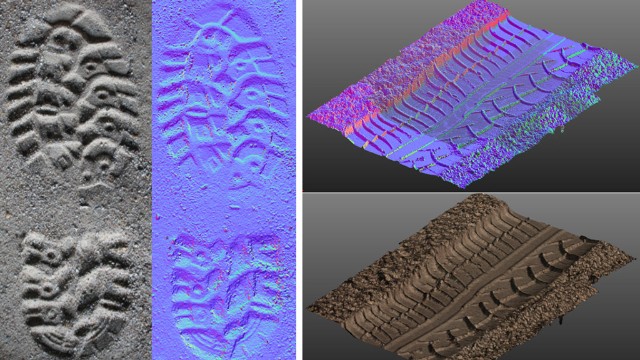
3D Scanners Enhance Forensic Investigations at Crime Scenes

Down to the smallest detail - analysis and results of 3D scans of shoe and tire impressions.
© Fraunhofer IOF
If the police commissioner in TV crime series finds a corpse, the forensic collects DNA traces, secures fingerprints, takes photos and casts shoe prints, tire tracks or other traces with plaster. The actual securing of evidence of the criminal investigation department works in a similar way.
However, the information content of photos is limited – for example, it is not possible to derive any depth information from them. Even the plastering of shoe prints and the like has its limits: On one hand, the trace is destroyed after plastering.
On the other hand, the plaster needs time to harden, especially in a wet or cold environment it hardens only with difficulty. The portable device works contactless and is easy to handle
The portable “3DF scanner” makes it possible to secure the tracks easily, quickly and without destruction. It was developed by researchers from the Fraunhofer IOF together with industrial partners. “The scanner records the tracks in three dimensions” says Roland Ramm, a scientist at Fraunhofer IOF.
“At only 4.3 kilograms, it is very light, battery-powered and robust against weather and temperature. Besides, it works without contact, so the trace is still intact after scanning.”
The device can reliably detect even the smallest features, its resolution is below 200 micrometers. Because more important than the shoe size or brand, for example, are small scratches in the shoe profile, which the criminal investigation department can use to assign a shoe print to a specific shoe.
In everyday life, the examination with the scanner looks like this: The forensics holds the device over the trace, for example, the shoe print, and starts the recording. At the same time, a camera attached to the scanner takes a photo. A few seconds later the user sees a preview image on the integrated display.
On this the user can see whether the image section fits, the image is sharp, and already receives the first results. The detailed evaluation follows in the laboratory because it is usually carried out by other colleagues, such as trassologists.
Here, for example, the length of an imprint or the depth of the shoe profile can be analyzed, and comparisons can be made with traces from other crime scenes or a perpetrator.
To measure the tracks three-dimensionally, the researchers have relied on the pattern projection. Each of the two cameras, which look at the track from slightly different angles, take an image, while a small projector beams a stripe pattern onto the track.
Geometric statements can be made based on the deformation of the beamed pattern. The measurement uncertainty is only 20 to 100 micrometers. The validity of the data is thus at least as high – if not higher – than that of data obtained from plastering.
Presentation at the GPEC trade fair in Frankfurt
In the meantime, the device is marketed by the Italian company Gexcel, which also offers the appropriate evaluation software. Interested police authorities can also borrow the portable 3D scanner from Fraunhofer IOF for test purposes. At the “General Police Equipment Exhibition & Conference GPEC” trade fair in Frankfurt am Main from February 18 to 20, 2020, Fraunhofer IOF researchers will present the “3DF Scanner” (Hall 11.1, Stand E120).
Visitors will be able to try out the device live on various tracks, and the evaluation software from Gexcel can also be tested using data from simulated crime scenes.
Wissenschaftliche Ansprechpartner:
Contact:
Roland Ramm
Roland.Ramm@iof.fraunhofer.de
Phone +49 3641 807-213
Weitere Informationen:
https://www.iof.fraunhofer.de/en/pressrelease/2020/3D-forensic-scanner.html












